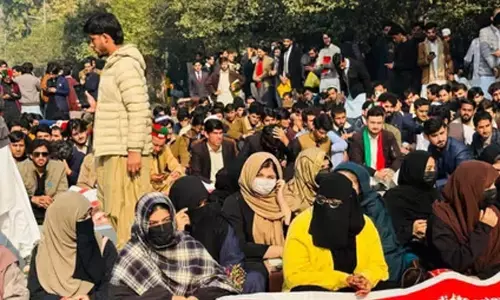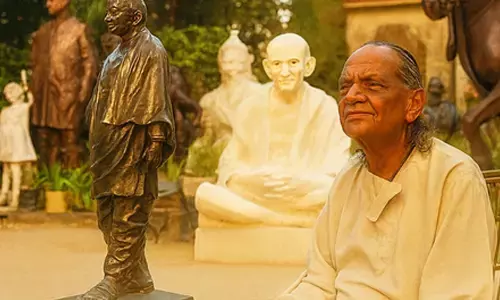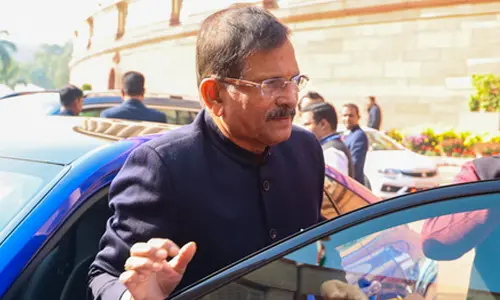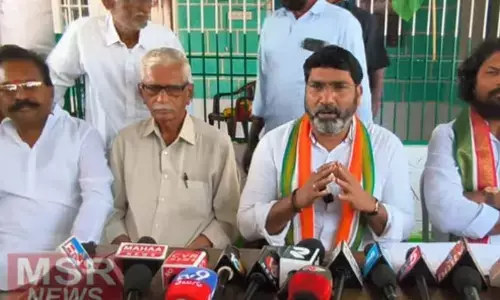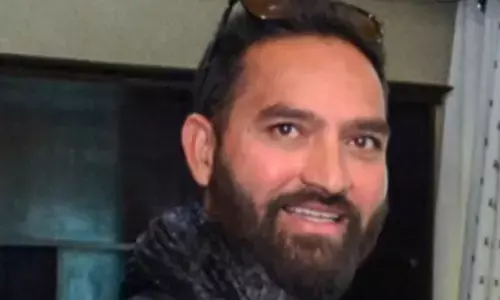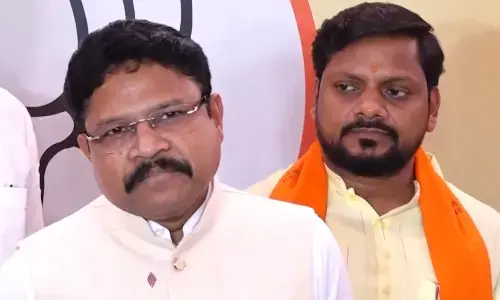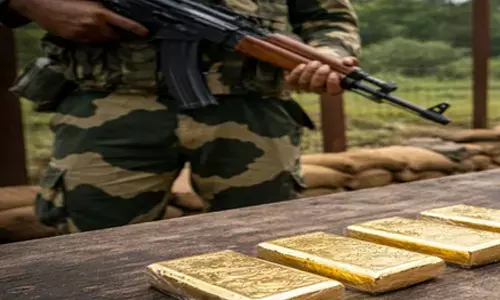How Andhras were denied a capital of their own
The contention of the Andhras at the time of creation of Andhra State to include Madras is very much akin to that being made at present by the leaders of Coastal Andhra and Rayalaseema regarding the status of Hyderabad
…the Silver Jubilee Session of Andhra Maha Sabha at Bezwada in October 1937 was virtually a celebration of winning Madras city. How that dream could not be realized and how the people of Coastal Andhra and Rayalaseema were driven to Hyderabad with a brief stopover in Kurnool is a very important part of recent history
Though the Jai Andhra movement in 1972 did not involve any territorial claims on Hyderabad, the current agitation of Andhras for Hyderabad has emotional and sentimental aspects with deep roots
K Ramachandra Murthy
The contention of the Andhras at the time of creation of Andhra State with the inclusion of Madras is very much akin to that being made at present by the leaders of Coastal Andhra and Rayalaseema regarding the status of Hyderabad
…the Silver Jubilee Session of Andhra Maha Sabha at Bezwada in October 1937 was virtually a celebration of winning Madras city. How that dream could not be realized and how the people of Coastal Andhra and Rayalaseema were driven to Hyderabad with a brief stopover in Kurnool is a very important part of recent history Though the Jai Andhra movement in 1972 did not involve any territorial claims on Hyderabad, the current agitation of Andhras for Hyderabad has emotional and sentimental aspects with deep roots
The decision of the Congress party to concede the demand for a separate statehood for Telangana has naturally plunged the people of Coastal Andhra and Rayalaseema into a state of confusion and uncertainty. Had the decision been to create Telangana State without including in it the city of Hyderabad, the leaders of Coastal Andhra and Rayalaseema would have wholeheartedly welcomed it. They would have hugged and congratulated their Telangana brethren, wishing them all the best. Since it would be a virtual demerger, with Hyderabad continuing to remain in Telangana, the leaders as well as ordinary people are not able to digest it. This explains the movement for integration that is gathering momentum in 13 districts of Andhra Pradesh ever since the decision on Telangana was announced.
The public discourse in Coastal Andhra and Rayalaseema is focused on two important aspects: Hyderabad and the future capital. The rest of the debate is incidental and the verbal attacks on K Chandrasekhara Rao, the TRS chief, for his comments on the employees of Andhra origin, are reactive. While emotional hurts leading to disparaging remarks and harsh comments are temporary and understandable in the surcharged atmosphere, KCR is seen as a villain of the piece in Coastal Andhra and Rayalaseema so much so that whatever he says would now be interpreted negatively. This is the image he has created for himself in the eyes of Andhras with his acerbic comments.
More than jobs and waters, it is Hyderabad that is the bone of contention. New jobs will have to be created in the emerging State and water distribution can be taken care of by a commission or a tribunal appointed by the Union government. In fact, already some guidelines are in place regarding distribution of river waters among the regions. But the battle for Hyderabad has emotional and sentimental aspects with deep roots.
The Jai Andhra movement in 1972, spearheaded by ‘Iron Man of Andhra’ Kakani Venkataratnam, did not involve any territorial claims on Hyderabad. Why then are the Coastal and the Rayalaseema leaders so particular and touchy about Hyderabad now? For one, there had been a lot of migration from all the districts to Hyderabad city, which has since developed much more rapidly than the rest of the State. Secondly, and more importantly, having Hyderabad as capital would spare the people of Coastal Andhra and Rayalaseema the trouble of locating and building a new capital. So, decisions on the new capital are bound to be more contentious and intriguing than those relating to jobs and water sharing.
To know the torturous process of locating a capital post-bifurcation, one only has to refer to the pages of history describing events that took place six-and-half-a-decades ago. The arguments of present leaders of Coastal Andhra and Rayalaseema on Hyderabad look strikingly similar to the postulates of the then leaders with regard to Madras just before the two regions were partitioned from the erstwhile Madras province on linguistic basis.
The then leaders of separate Andhra movement spoke of their contribution to the development of Madras city, their apprehensions about jobs and educational facilities, and their emotional attachment to the coastal city. The proposals made by the Andhras at that time on the desired status of Madras are again akin to the points being made by the leaders of Coastal Andhra and Rayalaseema regarding the status of Hyderabad.
K V Narayana Rao, a retired professor of political science & public administration, Sri Venkateswara University, Tirupati, had in his illuminating paper titled, ‘The Andhras in the quest of capital for Andhra Province/State,’ described the problems that cropped up during the search for a new capital. It is interesting to know how the Andhras pitched for Madras and discussed various options before settling for Kurnool, after five non-Andhra members voted against an amendment suggesting that Kurnool was not the right choice.
Union Minister for Tourism Chiranjeevi has been demanding that Hyderabad should be made a Union Territory. Prof Ilaiah from Telangana also has suggested the same status for the city. Many leaders of the movement opposed to bifurcation are making the same or similar demand. Many are worried about the future of 20 to 25 lakh people in Hyderabad whose moorings lie in one or the other of the 13 districts of Coastal Andhra and Rayalaseema presently on the boil. There are a number of other proposals like making Hyderabad a joint capital for ever by creating a corridor from Kurnool to Hyderabad via Mahbubnagar so that Andhra and Hyderabad would become contiguous.
The model hinted at by Digvijay Singh is analogous to the status of Delhi metropolis in Delhi State. Let us, if only to satiate our academic interest, examine what happened before Kurnool was made the capital of Andhra. I will be quoting extensively from Prof Narayana Rao’s eminent work.
The protagonists of separate Andhra did not consider at the beginning Madras as a Telugu city. The maps of Andhra province published at that time (more than a hundred years ago) excluded Madras. Things changed only after the venerable Konda Venkatappayya, in his speech at the Bapatla Conference of the Andhra Maha Sabha (AMS) in 1913, said that if one perused the history of Madras and deduced the importance of the Andhra merchants in it, it was clear that the Andhras, like others, had claims over the city. O V Rangayya Pantulu, Chairman of the Reception Committee for the Nellore Conference of AMS in 1917, was the first leader to suggest that Madras could be the capital of Andhra and some other place (like Madurai or Tiruchirapalli) the capital of the residuary Madras province. Persistent demands to include Madras in the Andhra province began in 1918. The Andhra Provincial Congress Committee (APCC) included Madras in its jurisdiction. Subsequent AMS Conferences demanded the creation of an Andhra Province with 12 districts, including Madras.
The Congress party was as indecisive during the tenure of Annie Besant, the first woman president of the party, as it is ambivalent now under the stewardship of Sonia Gandhi. The lady of Irish origin, who was leading the party during the freedom movement, had fewer hassles compared to the riddles and pitfalls faced by the present presiding deity of Italian roots who is deeply involved in ruling independent India, which, in the turbulent 1960s, was aptly described by John Kenneth Galbraith, an American ambassador to India, as “the greatest example of functional anarchy”.
Forming new States on linguistic basis is an old concept. As a precursor, the Congress party was reorganised in 1920 on the basis of language. It was then that the issue of jurisdiction over Madras city cropped up. G Sitarama Sastry, who later became Swami Sitaram and created a mild sensation with his not so serious satyagraha for separate statehood, was the general secretary of the Andhra Provincial Congress Committee (APCC). It was he who suggested first that Madras city can be made a separate province like Bombay. The Congress High Command heard the claims made both by the APCC and the Tamil Nadu Congress Committee (TNCC) and allowed them to enlist members from any and every ward of the city.
The Andhras entertained hopes that a separate Andhra province would be carved by the British in 1930s itself. Rangaiah Naidu, chairman of the reception committee for Madras conference of AMS in 1924 and a resident of the city, contended that Madras was clearly an Andhra city. Two years later, Sir Sankaran Nair, a Malayalee, stated that Madras was half Telugu and half Tamil. Ramadas Pantulu’s resolution in the Council of States included northern portion of Madras as part of Andhra Province.
Sir Panaganti Ramarayaningar, Raja of Panagal, regarded as a great democrat and twice chief minister of Madras Presidency, was in favour of Madras being retained as the Andhra capital (The Raja, who was zamindar of Kalahasti in Chittoor district, was instrumental in developing T Nagar (in Madras) where a park, named after him, has his statue as well. It is a different matter that we have no such tradition of commemoration). Ramadas Pantulu was keen on having Madras as the capital of Andhra, pending amicable location of a new capital for all the 12 districts.
How close the Telugus of Madras province were to getting the city for their future province can be seen by the narrow margin with which an amendment aimed at making the city the capital of Andhra Province was lost in Madras Legislative Council in 1933. While 19 members voted in favour of the resolution, 20 were against it and 22 remained neutral. Of the elected members, 15 were for the resolution and 12 against and six neutral. This close encounter had alerted the Tamil leaders who started their campaign to keep Madras with Tamil Nadu. S Satyamurti, an extraordinary Parliamentarian, led the campaign for Madras. Chakravartula Rajagopalacharyulu (CR), a national leader who rubbed shoulders with Gandhi, Nehru and Patel, announced retirement from public life in 1935.
It was then that Satyamurti, the mentor of Kumaraswami Kamaraj Nadayar, became the president of the TNCC, while the APCC was headed by Bulusu Sambamurthy, a great patriot who served as the president of Madras Legislative Council (here again, while Satyamurti was gratefully remembered by Tamils who named the headquarters of Tamil Nadu Congress Committee as Satyamurti Bhavan, we neglected, nay insulted, Maharshi Sambamurthy, who died in Kakinada in penury).
After a lot of arguments within the Congress party about the status of Madras city, Sambamurthy agreed to make Madras a separate Congress circle reserving for itself the right to claim Madras city as part of Andhra Province when it is created. Satyamurti’s reluctance to accept the proposal resulted in status quo. The leaders of APCC and TNCC used to consult one another and cooperate in the selection of candidates from Madras city in all elections between 1920 and 1946. Tanguturi Prakasam Pantulu and some other Telugu leaders had won elections from constituencies in Madras city. But the Silver Jubilee Session of AMS held at Bezwada (Vijayawada) in October 1937 was virtually a celebration of winning Madras city. How that dream could not be realized and how the people of Coastal Andhra and Rayalaseema were driven to Hyderabad with a brief stopover in Kurnool is a very important part of recent history.








